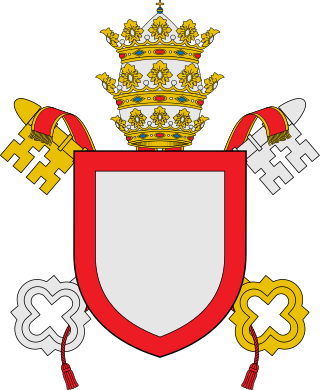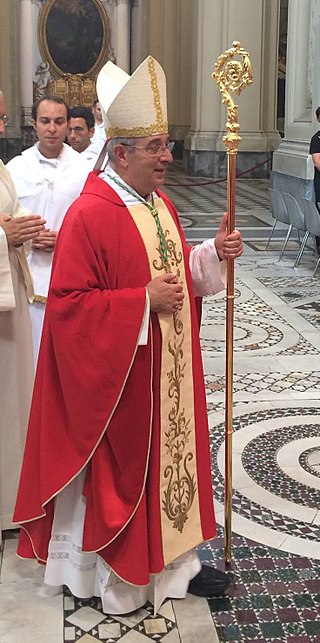In the canon law of the Catholic Church, canonical provision is the regular induction into a benefice.
 |
| Part of a series on the |
| Canon law of the Catholic Church |
|---|
| |
In the canon law of the Catholic Church, canonical provision is the regular induction into a benefice.
It comprises three distinct acts - the designation of the person, canonical institution, and installation. In various ways a person may be designated to fill a vacant benefice: by election, postulation, presentation, or recommendation, resignation made in one's favour, or approved exchange. In all cases confirmation by the proper ecclesiastical superior of the selection made is required, while letters of appointment, as a rule, must be presented.
Reception of administration by a chapter without such letters brings excommunication reserved to the pope, together with privation of the fruits of the benefice; and the nominee loses ipso facto all right to the prelacy. Ordinarily greater benefices are conferred by the pope; minor benefices by the bishop, who as a rule has the power of appointing to all benefices in his diocese. The pope, however, owing to the fullness of his jurisdiction, may appoint to any benefice whatsoever.
In England, since a charter of 1214, bishops had been appointed by free canonical election of cathedral chapters. [1] Therefore in the thirteenth century, it was unusual for a bishop to be appointed by papal provisions, however by the fourteenth century it had become much more common. [2] When the Hundred Years War between France and England started in 1337, the papal court sat in Avignon and favored France, so relations between England and the papacy became increasingly tense. The pope filled many of the English vacancies with his own appointees. These appointees did not reside in England, but collected revenues from their benefices anyway. When some of these revenues found their way into the French royal treasury, many Englishmen complained to Parliament about the abuse, and an English statute (Statute of Provisors) was enacted in 1351 to prevent the pope from exercising several of his prerogatives. Similar enactments were made in 1390 and in later years. [3] These statutes were finally repealed by the Statute Law Revision Act 1948.
At present, the Pope makes use of this right only in certain defined circumstances. The bishop's power is further restricted at times to confirming an election or postulation; or to approving candidates presented by one who enjoys the right of presentation by privilege, custom, or prescription.
Canonical institution or collation is the concession of a vacant benefice by one who has the authority. If made by the sole right of the prelate, it is free; if made by legal necessity, for example, after due presentation or election, or at the command of a superior, it is styled necessary. An ecclesiastical benefice cannot be lawfully obtained without canonical institution.
Installation, called corporal or real institution, is the induction into the actual possession of a benefice. In the case of a bishop it is known as enthronization or enthronement. Corporal institution, according to common law, belongs to the archdeacon; by custom to the bishop or his vicar-general. It may take place by proxy: the rite observed depends much on custom.
To installation belong the profession of faith and oath, when prescribed.

The First Council of the Lateran was the 9th ecumenical council recognized by the Catholic Church. It was convoked by Pope Callixtus II in December 1122, immediately after the Concordat of Worms. The council sought to bring an end to the practice of the conferring of ecclesiastical benefices by people who were laymen, free the election of bishops and abbots from secular influence, clarify the separation of spiritual and temporal affairs, re-establish the principle that spiritual authority resides solely in the Church and abolish the claim of the Holy Roman Emperor to influence papal elections.

Pope Benedict XII, born Jacques Fournier, was head of the Catholic Church from 30 December 1334 to his death in April 1342. He was the third Avignon pope and reformed monastic orders and opposed nepotism. Unable to remove his capital to Rome or Bologna, Benedict started the great palace at Avignon. He decided against a notion of Pope John XXII by saying that souls may attain the "fulness [sic] of the beatific vision" before the Last Judgment. Despite many diplomatic attempts with Emperor Louis IV to resolve their differences, Benedict failed to bring the Holy Roman Empire back under papal dominance. He died 25 April 1342 and was buried in Avignon.

Pope Boniface IX was head of the Catholic Church from 2 November 1389 to his death in October 1404. He was the second Roman pope of the Western Schism. During this time the Avignon claimants, Clement VII and Benedict XIII, maintained the Roman Curia in Avignon, under the protection of the French monarchy. He is the last pope to date to take on the pontifical name "Boniface".

Simony is the act of selling church offices and roles or sacred things. It is named after Simon Magus, who is described in the Acts of the Apostles as having offered two disciples of Jesus payment in exchange for their empowering him to impart the power of the Holy Spirit to anyone on whom he would place his hands. The term extends to other forms of trafficking for money in "spiritual things".
In English history, praemunire or praemunire facias refers to a 14th-century law that prohibited the assertion or maintenance of papal jurisdiction, or any other foreign jurisdiction or claim of supremacy in England, against the supremacy of the monarch. This law was enforced by the writ of praemunire facias, a writ of summons from which the law takes its name.

The Investiture Controversy, also called Investiture Contest, was a conflict between the Church and the state in medieval Europe over the ability to choose and install bishops (investiture) and abbots of monasteries and the pope himself. A series of popes in the 11th and 12th centuries undercut the power of the Holy Roman Emperor and other European monarchies, and the controversy led to nearly 50 years of conflict.

Richard Poore or Poor was a medieval English bishop best known for his role in the establishment of Salisbury Cathedral and the City of Salisbury, moved from the nearby fortress of Old Sarum. He served as Bishop of Chichester, Bishop of Salisbury and Bishop of Durham.
A benefice or living is a reward received in exchange for services rendered and as a retainer for future services. The Roman Empire used the Latin term beneficium as a benefit to an individual from the Empire for services rendered. Its use was adopted by the Western Church in the Carolingian Era as a benefit bestowed by the crown or church officials. A benefice specifically from a church is called a precaria, such as a stipend, and one from a monarch or nobleman is usually called a fief. A benefice is distinct from an allod, in that an allod is property owned outright, not bestowed by a higher authority.

An enthronement is a ceremony of inauguration, involving a person—usually a monarch or religious leader—being formally seated for the first time upon their throne. Enthronements may also feature as part of a larger coronation rite.
Annates were a payment from the recipient of an ecclesiastical benefice to the ordaining authorities. Eventually, they consisted of half or the whole of the first year's profits of a benefice; after the appropriation of right of consecration by the Vatican, they were paid to the papal treasury, ostensibly as a proffered contribution to the church. They were also known as the "first fruits", a religious offering which dates back to earlier Greek, Roman, and Hebrew religions.
In canon law the confirmation of a bishop is the act by which the election of a new bishop receives the assent of the proper ecclesiastical authority.
The Concordat of Bologna (1516) was an agreement between King Francis I of France and Pope Leo X that Francis negotiated in the wake of his victory at Marignano in September 1515. The groundwork was laid in a series of personal meetings of king and pope in Bologna, 11–15 December 1515. The concordat was signed in Rome on 18 August 1516. It marked a stage in the evolution of the Gallican Church.

Cardinal Vicar is a title commonly given to the vicar general of the Diocese of Rome for the portion of the diocese within Italy. The official title, as given in the Annuario Pontificio, is Vicar General of His Holiness.
Cathedraticum is a specified sum of money to be paid annually toward a bishop. It is a mark of honour and a sign of subjection to the cathedral church, from which its name is derived.
The right of patronage in Roman Catholic canon law is a set of rights and obligations of someone, known as the patron in connection with a gift of land (benefice). It is a grant made by the church out of gratitude towards a benefactor.
The Apostolic Datary was one of the five Ufficii di Curia in the Roman Curia of the Roman Catholic Church. It was instituted no later than the 14th AD. Pope Paul VI abolished it in 1967.
Walter de Coventre was a 14th-century Scottish ecclesiastic. There is no direct evidence of his birthdate, his family, or his family's origin, although he may have come from the region around Abernethy, where a family with the name de Coventre is known to have lived. Walter appeared in the records for the first time in the 1330s, as a student at the University of Paris. From there he went on to the University of Orléans, initially as a student before becoming a lecturer there. He studied the arts, civil law and canon law, and was awarded many university degrees, including two doctorates. His studies were paid for, at least partially, by his benefices in Scotland. Despite holding perhaps more than five benefices at one stage, he did not return to Scotland until the late 1350s.
Canonical institution is a technical term of the canon law of the Roman Catholic Church, meaning in practice an institution having full recognition and status within the Church.

The English statute usually called Statute of Provisors is the 25th of Edward III, St. 4 (1350–51), otherwise termed "The Statute of Provisors of Benefices", or anciently De provisoribus. This measure was central to a long disagreement between the English kings and the Roman Curia, concerning filling of ecclesiastical benefices.
A rector is, in an ecclesiastical sense, a cleric who functions as an administrative leader in some Christian denominations. In contrast, a vicar is also a cleric but functions as an assistant and representative of an administrative leader.